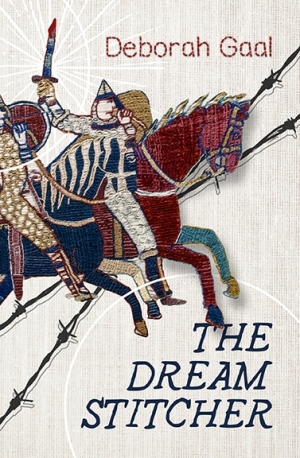The Dream Stitcher
The Dream Stitcher is a deeply satisfying story in which complex characters come to terms with a painful past.
In Deborah Gaal’s novel The Dream Stitcher, the past, present, fantasy, and reality come together to showcase hope and love thriving, even in the darkest circumstances.
The book moves between Nazi-occupied Poland and contemporary Southern California. Closer to the present, a widow and retired executive, Maude, struggles to save her home from foreclosure. She returns to work and cuts costs by moving her memory-challenged mother, Bea, from a pricey retirement home in to live with her. Maude enlists her pregnant daughter, Rosie, to help care for Bea, a difficult woman who shared few details about her past even before Alzheimer’s disease took hold. That past comes to light through chapters about Goldye, a Polish Jew who discovers she has the talent to sew dreams into reality—first for the non-Jewish brides of Warsaw, then for the freedom fighters and persecuted Jews trying to escape Nazi oppression during World War II.
The plot flows nearly seamlessly between the past and near present. The shorter Southern California chapters chronicle familiar struggles: balancing work, family, and finances. These are interspersed with longer looks at wartime Poland, where vivid descriptions of the sick and starving captives of Warsaw’s ghetto are made bearable by the believable magic of Goldye’s embroidered creations coming to life.
A tapestry that Bea embroiders, modeled after a Norman artifact, ties the time periods together and becomes a character in its own right; its stitched horses and hummingbirds sometimes seem to spring to life. It also connects characters to Queen Mathilda, the wife of William the Conquer, whom tradition credits with creating the original work. Mathilda serves as a guiding voice for Goldye, helping her to stitch symbols that give people hope as well as darker images of death and destruction.
An integral love story between Goldye and a freedom fighter, Lev, adds bright moments. The relationship is fueled by dialogue that is both romantic and painfully realistic given the couple’s bleak circumstances. Other secondary characters, including Goldye’s parents, her mentor and adopted uncle Jan, and Lev’s cousin and fellow freedom fighter Katya, are also well developed, making it easy to understand how love, loss, and the horrors of war motivate them to make their agonizing choices. A brief prelude provides background on why Jan would risk his life to help Goldye escape Warsaw’s ghetto while, at the same time, taking in a widower and her son, a member of the Hitler Youth.
Some characters in the California cast are less fleshed out, especially Rosie, who appears as a relentlessly positive, heavily pregnant counterweight to Maude, whose lifelong self-doubt has been nurtured by Bea’s secrecy, suspicion, and reluctance to share even the identity of Maude’s father. On the other hand, because of her complicated relationship with her own mother, Maude’s motivations are clear and earn easy empathy from anyone who’s grappled with feelings of abandonment.
Maude isn’t the only one struggling to balance doubts and dreams. The Dream Stitcher is a deeply satisfying story in which complex characters come to terms with a painful past.
Reviewed by
Charlene Oldham
Disclosure: This article is not an endorsement, but a review. The publisher of this book provided free copies of the book and paid a small fee to have their book reviewed by a professional reviewer. Foreword Reviews and Clarion Reviews make no guarantee that the publisher will receive a positive review. Foreword Magazine, Inc. is disclosing this in accordance with the Federal Trade Commission’s 16 CFR, Part 255.

